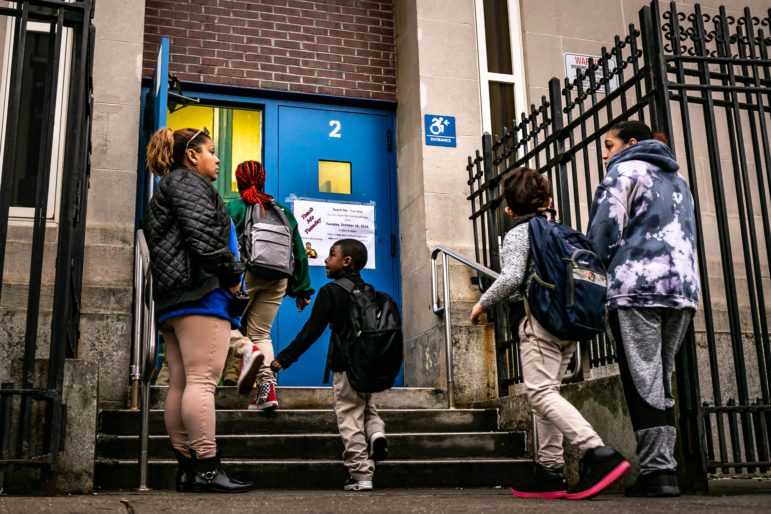
Great teachers have the power to change lives. Those of us who are particularly fortunate may have had several great teachers over our years in school. However, the experience of having an excellent teacher every school year is not a given for New York City’s most underserved students. As detailed in City Limits’ five-part series, African American and Latinx youth living in low-income communities across the city disproportionately experience teacher shortages and turnover and suffer the consequences both in terms of school climate and academic outcomes.
If we are serious about equity, then there is a moral imperative to provide teachers, especially new teachers serving our highest-needs students, the tools and support they need from the get-go.
Over my 20 years working in and with New York City public schools, I’ve witnessed the frustration and tears of teachers who feel as though they are failing their students. I speak with teachers who don’t feel they are providing students what they need and deserve, and who are not getting the support they need to get better. We need to help new teachers get better faster because our kids can’t afford to wait.
The most important predictor of a student’s academic success is the quality of her teacher. We also know that chronic teacher churn has a devastating effect on our most marginalized students. The Learning Policy Institute found that teachers in schools with 25 percent or more students of color “were more likely to move or leave teaching than teachers in schools with fewer students of color, all else being equal.”
The question, then, is how can we get teachers to stay?
According to Richard Ingersoll of the Center for the Study of Teaching and Policy, there are three factors that most directly determine whether or not a teacher stays: 1) inspiring and supportive communication from school leaders, 2) high quality mentoring and supportive professional communities; and 3) being empowered to enact positive change for young people and their schools.
New teachers become stronger practitioners and stay in their schools when districts make a long-term commitment to comprehensive, instructionally-focused new teacher mentoring. And the youth in our highest need and hardest-to-staff schools stand to gain the most from such an investment.
NYCDOE is working towards ensuring that new teachers receive the type of support that can elevate their instruction, classroom management, and overall effectiveness. Through a partnership with New Teacher Center, ten of the highest need and hardest to staff districts have trained cadres of highly skilled instructional mentors to support teachers in their first two years of the profession. The mentoring model marries an instructional focus with social and emotional learning needs and helps teachers create the conditions for an Optimal Learning Environment in their classrooms. By building the capacity of both instructional mentors and school leaders as teacher developers and culture shapers, we create ecosystems in schools where early career teachers not only survive but thrive. And so do their students.
We’ve seen amazing returns on this investment, in terms of student achievement and teacher retention.
Preliminary results from the U.S. Department of Education’s i3 Scale-Up study (which includes NYC) found that when new teacher mentors receive New Teacher Center’s professional learning and use the model’s tools and processes, new teacher practice improves and their students learn more. Data from school-based mentoring sites showed up to 7 months additional learning in Math among students taught by teachers supported in the model, as compared to their peers who were not.
The retention rates for new teachers in participating districts in the city are improving as well. In District 9, a South Bronx community located in the poorest congressional district in America, educators who received the NTC mentoring model remained in their schools at a rate of 91 percent in 2015, compared to 72 percent of teachers who did not benefit from the mentoring program. In District 12, also a high need district in the Bronx, the first year teacher retention rate was 80 percent for those supported in the model, versus 71 percent for those who were not.
Over the past seven years, as I’ve led New Teacher Center’s work in NYC, I have directly seen this impact. We have engaged with new teachers, mentors, and principals across the five boroughs, and have seen the shift in teachers’ classrooms, confidence, and the quality of their students’ work when after they partner with a well-trained mentor. The student achievement results we are seeing echo the optimism these teachers feel when they are equipped with the skills to meet their students’ needs.
Talented, caring, skillful teachers make students want to show up. They push young people to reimagine their futures and aspire to great things. They help them achieve more in the classroom, and propel them to carry that confidence into their communities and beyond. The current administration of the NYCDOE is, thankfully, working to double-down on the investment in our next generation of teachers by providing the comprehensive teacher induction and early career coaching support they need. We hope this commitment can be deepened and sustained. This is how teachers go from surviving to thriving, and how we can truly move the needle for kids in New York City
Thandi Center is the senior director at the New Teacher Center in New York City.








